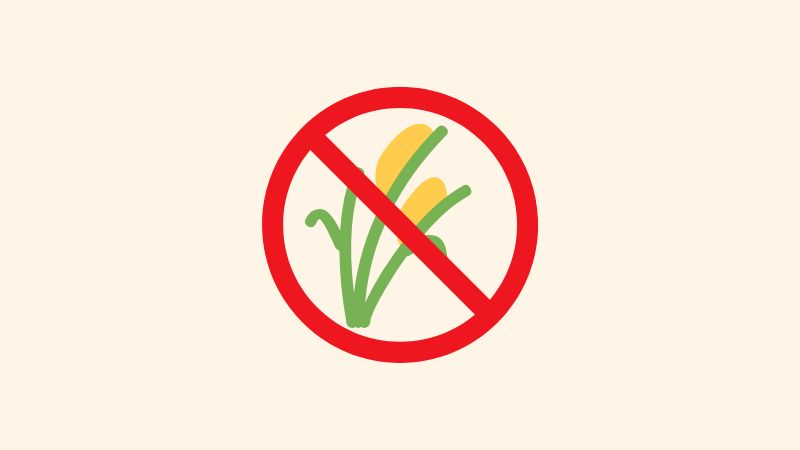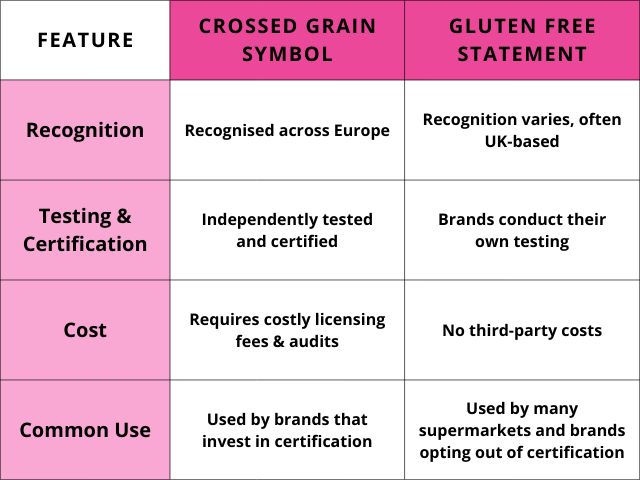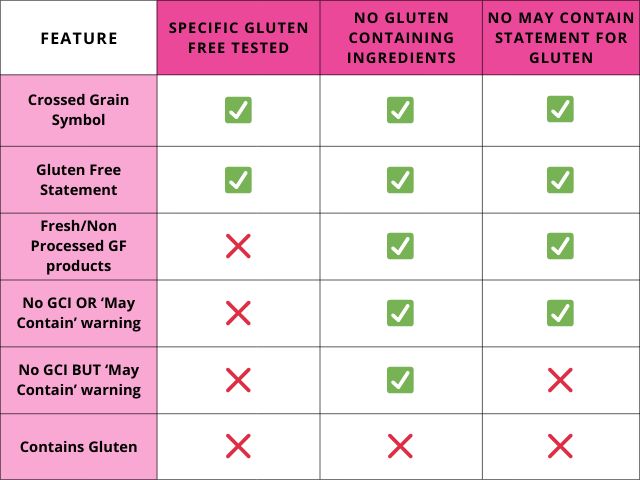Crossed Grain Symbol
Information on the crossed grain symbol and other gluten free statements


Fast Facts:
⚡ The Crossed Grain symbol and a Gluten Free Statement mean the same thing; both have to be tested to meet the legal threshold of 20 ppm or less of gluten
⚡ The Crossed Grain symbol involves third-party certification and licensing fees, making it more expensive for brands
⚡ Some products meet gluten free standards but don't carry any specific gluten free label, simply to avoid extra testing or costs seen as unnecessary
⚡ Even without a label, you can often confirm if a product is gluten free by checking the ingredients list and allergen statement
❓ What is the Crossed Grain Symbol?
The Crossed Grain symbol is one of the most recognised signs of a gluten free product, especially across Europe. Managed by the Association of European Coeliac Societies (AOECS), it shows an ear of wheat crossed out - and is a simple, visual cue that the product is safe for people with coeliac disease or anyone following a gluten free diet.
To use it, brands must:
- Apply for a license via their national coeliac society (e.g. Coeliac UK)
- Test their products for gluten levels
- Undergo regular audits of their production processes
- Pay ongoing certification and licensing fees
While trusted, the symbol is not mandatory. Any product labelled 'gluten free' in the UK or EU must meet the same legal standard - 20 ppm or less of gluten - whether it carries the symbol or not.
✅ Pros of the Crossed Grain Symbol:
- Instant, international recognition
- Rigorous third-party testing and auditing
❌ Cons of the Crossed Grain Symbol:
- Licensing fees and audits can be expensive
- Not required by law
❔ What is a Gluten Free Statement?
A gluten free statement is simply a declaration on packaging confirming that a product meets the legal gluten free threshold. This can be any wording/image and unlike the Crossed Grain symbol, this doesn’t require third-party licensing. Many UK supermarkets, including Tesco and Aldi, and well known brands use their own gluten free branding instead of the Crossed Grain symbol. Their products still meet legal gluten free standards but avoid third party licensing fees.
Brands can:
- Conduct their own gluten testing
- Include their own symbol or 'gluten free' wording on packaging
✅ Pros of a Gluten Free Statement:
- No licensing or certification costs
- Easier for supermarkets or small brands to use
❌ Cons of a Gluten Free Statement:
- Not always instantly recognisable
- May not be trusted or understood in other countries

🟰 Bottom Line
The statement and the Crossed Grain symbol mean the same thing - the product is gluten free to legal standards - and although the symbol is more widely recognised, many brands and supermarkets may choose to use their own gluten free statement to avoid additional costs.
🤔 What If There’s No Symbol or Statement?
Some gluten free products don't include any label at all. This is usually because:
- 💸 Cost - Gluten testing or licensing adds expense, especially for small companies
- 📃 Clarity from ingredients - Some brands rely on consumers checking ingredient lists to understand if something is gluten free
- 🔝 Prioritisation - Brands may only test and label high-risk products (like bread or sauces) rather than foods that are 'obviously' gluten free
You can still determine whether an item is gluten free by:
- Checking the ingredient list for gluten-containing grains (barley, rye, oats, wheat)
- Looking at the allergen information and identifying any 'may contain' warnings for gluten
- Visiting the brand's website or contacting them if you're unsure
This is why it’s so important to read and understand labelling on food packaging in the UK. 👉🏽 Check out our guide on label reading for more information.

⚠️ What About 'May Contain' Warnings
A product can legally be labelled gluten free even if it includes a 'may contain' warning for gluten sources - as long as final testing confirms it contains 2o ppm of gluten or less.
So why include a 'may contain' warning at all if it's gluten free?
- The warning refers to possible cross-contamination with with gluten-containing grains during manufacturing - not to confirmed gluten in the product itself
- Despite this, products undergo testing to ensure gluten levels are safely within the legal threshold for coeliac suitability
- The 'may contain' is there for people with non-gluten related allergies or intolerances to gluten grains, not just those avoiding gluten.
A great example of this is the Goodfella's gluten free pizza:
- It's clearly labelled gluten free
- But it also has a 'may contain traces of wheat' warning
- Why? Because while the gluten has been removed or reduced to safe levels, other wheat proteins may still be present in trace amounts - which can trigger reactions in people with wheat allergies
📚 Want to dive deeper?
👉🏾 Check out our full guide to ‘may contain’ warnings
🥦 Naturally Gluten Free Foods
Unprocessed foods like:
- Fresh fruit and vegetables
- Meat and fish
- Rice and legumes
…are naturally gluten free and don’t qualify for labelling under certification schemes like the Crossed Grain symbol. You won’t see a GF statement or symbol - but these foods are still safe unless contaminated during processing.
🎯 Quick Recap
The Crossed Grain symbol and Gluten Free statement both guarantee that a product contains 20 ppm or less of gluten, and are equally safe for those with coeliac disease. The Crossed Grain is certified and licensed, offering stronger brand recognition but at a higher cost. Some products meet gluten free standards without using any label due to cost or internal policy. Always read ingredient lists and allergen information, especially when a label is missing.